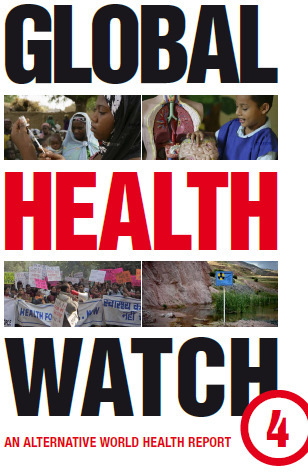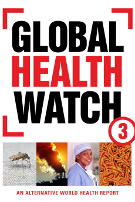13.04 Health system strengthening
The DG has committed to Health Systems Strengthening remaining a priority for WHO despite itsdifficult circumstances.
Documents for consideration by the WHA include:
- Resolution EB128.R12, 'Strengthening national policy dialogue to build more robust health policies, strategies and plans'
- Documents EB128/2011/REC/1 (? posted?). See provisional records of EB128
- Resolution EB128.R8, 'Sustainable health financing structures and universal coverage'
- Resolution EB128.R9, 'Health workforce strengthening'
- Resolution EB128.R10, 'Strengthening national health emergency and disaster management capacities and resilience of health systems'
- Resolution EB128.R11, 'Strengthening nursing and midwifery'
- A64/12, 'Health systems strengthening: Improving support to policy dialogue around national health policies, strategies and plans', report by Secretariat
- A64/13, 'HSS: Trends and Challenges' report by Secretariat
Further background at the Health Systems site on the WHO website.
See also Report of Taskforce on Innovative International Financing for Health Systems and McCoy commentary and Fryatt/Mills commentary
WHOWatch comment on the reports and resolutions on health systems strenghtening
The two reports (A64/12 and A64/13) provided by the Secretariat deal with the role of WHO in supporting national work towards health system strengthening.
These reports provide an overview over the current challenges and policy directions for health systems strengthening. The reports are however insufficient in addressing the political and socio-economic conditions that shape health systems. They are written largely from a technicist and donor perspective, focused on alignment, harmonisation and effectiveness. However, the importance of democratic participation of people’s movements at local, national and global level as crucial to shape people’s centred health systems is not acknowledged. It seems that the principles of Alma-Ata are being forgotten.
The reports acknowledge that health care reform is fundamentally a political process but the focus on the rational logic of ‘best practice’ does not offer any guidance with respect to the politics of health care reform in the unique circumstances of each country. In particular there is no mention of the advocacy, accountability and participatory role of civil society in driving health system reform. Historically, strong health systems have reflected the demands of political and social movements including the labour movement and public interest organizations. This dialogue goes beyond a technical construction of health sector reform, addressing the real needs of the people as part of a wider social protection strategy.
There is no mention in these reports of the policies of the World Bank which since 1993 have promoted the horizontal stratification of health systems (private for the rich, social insurance for the middle and minimal safety net packages for the poor), nor is there any explicit analysis of the contribution of the disease specific funding bodies in promoting vertical fragmentation and internal brain drain. There is no mention of IMF restrictions on ‘fiscal space’ in actually allocating public financial and human resources which may be available at national level.
We recognise the importance of an appropriate skill mix of health care workers. We support the trend of task shifting to community health workers, since evidence demonstrates that they can perform at least as well as highly educated health professionals in many situations provided they are properly trained, supported and remunerated. Nevertheless, we are concerned by the current trend of task shifting of health service provision from formally employed health personnel to informal and unpaid community health workers without the necessary health system support. We see this as a quick and cheap fix to provide basic care services by poorly remunerated,protected and trained community health workers. Additionally and importantly, over and above performing 'tasks', community health workers may act as social mobilisers for change, including catalysing intersectoral actions, a role that is not included in the WHO’s task shifting conception.
Harmonization and alignment of agencies and countries on health systems’ financing is a laudable goal as the IHP+ initiative and JANS framework demonstrate. But they should not be a goal on itself. Alignment does not prevent volatility of international health financing associated with changing economic conditions and domestic policies. Despite that G8 leaders pledged for sustained investments to reach the MDGs, there remains a large gap in the funds required to finance universal health coverage. Moreover, these finances are prone to fluctuation and receiving countries cannot rely on it for sustained support for their health sector budget.
We caution against relying solely on health insurance currently being promoted for LMICs as a sufficient strategy for health system strengthening. Health insurance addresses financial barriers to acess but such schemes tend to be essentially curative, not addressing promotive, preventive, and rehabilitative care. Health financing mechanisms should address resource development, regulatory capacity and service provision issues as well as access barriers. Social protection funds should not be used to strengthen the private sector in countries while at the same time weakening the public health care institutions.
The Secretariat Report on Trends and Challenges endorses the integrated service delivery model as the basis for health system strengthening. This is explained in terms of "networks of primary care providers – public, private or mixed – backed up by hospitals and specialized services. Such networks are responsible for the health of a defined population, offering health promotion, disease prevention, diagnosis, treatment, disease management, rehabilitation and palliative care. They integrate programmes targeting specific diseases, risks and populations, as well as personal and public health services".
The call to integrate private sector providers within district health systems is clearly linked with the promotion of demand side funding through health insurance. There is a certain logic to the call to recognise the reality of private sector providers but effective regulation of private providers is not simple and the coordination of public and private providers in 'integrated health care delivery' has proved to be very difficult, even in rich countries. It is highly irresponsible of WHO to be arguing for public subsidy to private providers as a blanket policy prescription in view of these complexities and difficulties.
One of the most critical elements of health system strengthening involves the rational use of medicines. Surprisingly there is no mention of this in either of the Secretariat reports. It seems that under continuing pressure from the pharmaceutical industry and subject to the funding preferences of large donors effective action on rational use of medicines has been relegated to the back burner. The widespread irrational use of medicines in the private sector in rich countries illustrates the challenge of effective regulation under the 'integrated service delivery' model.
We appreciate the references to a multisectoral approach to prevention and the need for health in all policies. The reports lack, however, guidance on leadership of the process to have concrete action on the social determinants of health being integrated into health systems strengthening.
See the Fourth Report of Committee A containing all 5 Resolutions with amendments made by Member States during the 64th World Health Assembly: A64/59




